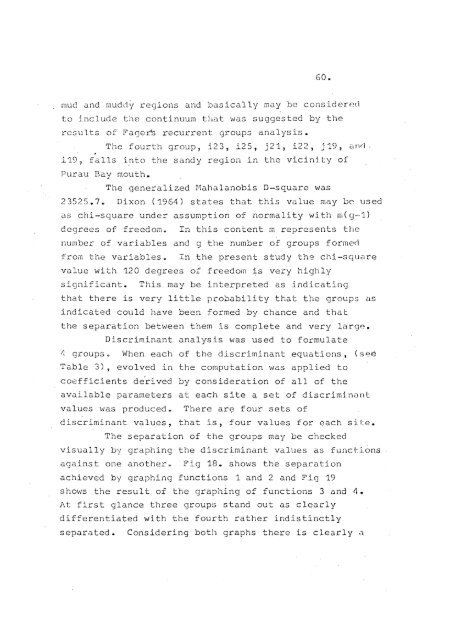The benthic ecology and community structure in Lyttelton Harbour ...
The benthic ecology and community structure in Lyttelton Harbour ...
The benthic ecology and community structure in Lyttelton Harbour ...
Create successful ePaper yourself
Turn your PDF publications into a flip-book with our unique Google optimized e-Paper software.
60.<br />
mud <strong>and</strong> mudd~<br />
regions <strong>and</strong> basically may be considererl<br />
to <strong>in</strong>clude the cont<strong>in</strong>uum that was suggested by the<br />
results of FaCJer~<br />
<strong>The</strong> fourth group,<br />
..<br />
119 7 falls <strong>in</strong>to the s<strong>and</strong>y<br />
Purau Bay mouth_<br />
recurrent groups analysis.<br />
123, i25, j21? i22, j19, <strong>and</strong>.<br />
on 1D the vic<strong>in</strong>ity of<br />
<strong>The</strong> generalized Mahalanobis D-square was<br />
23525.7~ Dixon (1964) states that th value may be used<br />
as chi-square under assumption of normality with m(g-l)<br />
degrees of freedom.<br />
In this content m represents the<br />
number of variables <strong>and</strong> 9 the number of groups formed<br />
from the variableso<br />
value with 120 degrees of freedom ~s<br />
In the present study th9 chi-square<br />
very highly<br />
significant. This may be <strong>in</strong>terpreted as <strong>in</strong>dicat<strong>in</strong>g<br />
that there very little probabi ty that the groups ilS<br />
<strong>in</strong>dicated could have been formed by chance <strong>and</strong> that<br />
the separation between them is complete <strong>and</strong> very large.<br />
Discrim<strong>in</strong>ant analys<br />
was used to formulate<br />
~ groups 0 When each of the discrim<strong>in</strong>ant equations J<br />
(se~<br />
Table 3), evolved <strong>in</strong> the computation was applied to<br />
coefficients d~~ived by consideration all of the<br />
available parameters each site a, set of discrim<strong>in</strong>C1nt<br />
values was producede <strong>The</strong>re ar~ four sets of<br />
d<br />
crim<strong>in</strong>ant values, that is, four values for each site.<br />
<strong>The</strong> separation of the groups may be checked<br />
visually by graph<strong>in</strong>g<br />
aga<strong>in</strong>st one anothero<br />
discrim<strong>in</strong>ant values as funct16ns<br />
Fig 18. shows the separation<br />
achieved by graph<strong>in</strong>g functions 1 <strong>and</strong> 2 <strong>and</strong> Fig 19<br />
shows the result of the graph<strong>in</strong>g of functions 3 <strong>and</strong> 4.<br />
At first glance three groups st<strong>and</strong> out as clearly<br />
differentiated with the fourth rather <strong>in</strong>dis<br />
nctly<br />
separated. Consider<strong>in</strong>g both graphs there is clearly a
















